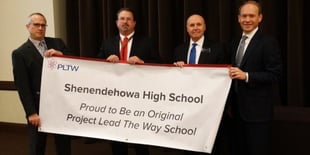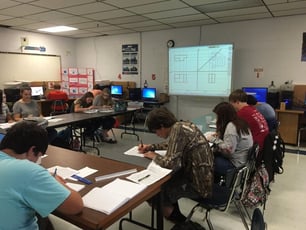Terry C. Nagy Jr. is a longtime teacher at Shenendehowa High School, located in the New York school district where the first PLTW courses were developed two decades ago. Terry has earned credits in Introduction to Engineering Design (IED) and Computer Integrated Manufacturing (CIM). Terry is a former IED Master Teacher – a role he was in for 12 years. Terry also served as an early curriculum writer for PLTW.
In the early ‘90s, before PLTW officially formed, teachers at my school taught early versions of IED, Principles of Engineering (POE), and Digital Electronics (DE). In 1996, my boss at the time, Dick Blais, left the district to work on getting PLTW off the ground. He had put together a very powerful advisory council that met frequently and helped raise the initial funding for PLTW, which got its start in 1997.
That year, around a dozen or so soon-to-be PLTW teachers from the area – the Capital District of New York – were summoned to a hotel in Syracuse for two days to be trained in a brand-new 3-D solid modeling software that had just been launched four months prior.
After the training, the group decided to keep in close contact and met at least once a month to have everyone contribute what they and their PLTW students were picking up. It worked great – we were able to keep in touch and share our experiences. In addition, there were several members of the group who took leadership roles and ended up being the first Master Teachers in IED.
The first version of the IED curriculum was well done but light in content, and we all found that we needed more goodies in it. This led to a new, fuller curriculum being developed for the following school year. Many teachers in the room, including myself, admitted we learned a lot from our students that year, as they were way more exploratory with the software than the teachers were. Many times I would watch over my students’ shoulders and pick up tips, then write them on a clipboard to be used as later lessons. We all grew that year with plenty of pains, but it was the model that was in place.
Fast forward to IED 20 years later, and there are many people on board willing to help and a deluge of resources are available. The curriculum is challenging and plenty full.
It’s been amazing to see this giant, successful program continue to grow and improve, knowing I was one of the original pieces of the puzzle.
In addition, it’s fulfilling to know we have better prepared our students for college-level engineering and given them a real taste of the field they are about to enter. Many students have come back after college and thanked me for turning them on to a successful career in engineering. They will usually also bring up a favorite PLTW project from our class time together.
Furthermore, when I was a Master Teacher, I got to meet many great educators from around the country and received great feedback after summer training was over. I have had several PLTW Professional Development participants tell me that they were about to leave teaching, but PLTW was changing their minds. They had gotten re-energized, and it had become fun again. Those were my favorite experiences.
My advice to all from teaching this for 20 years is don't be afraid to stretch out and try new things with the curriculum in your classroom. Don't treat it as a straight line; treat it as a circle where you can come back around and revisit, redo, and improve.
PLTW’s blog is intended to serve as a forum for ideas and perspectives from across our network. The opinions expressed are those of each guest author.

